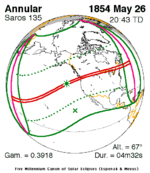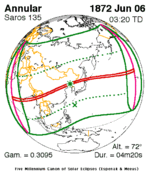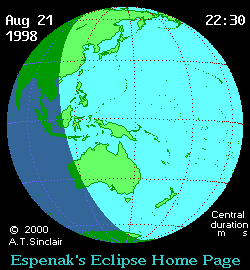Solar eclipse of August 22, 1998
| Solar eclipse of August 22, 1998 | |
|---|---|
| Type of eclipse | |
| Nature | Annular |
| Gamma | −0.2644 |
| Magnitude | 0.9734 |
| Maximum eclipse | |
| Duration | 194 s (3 min 14 s) |
| Coordinates | 3°00′S 145°24′E / 3°S 145.4°E |
| Max. width of band | 99 km (62 mi) |
| Times (UTC) | |
| Greatest eclipse | 2:07:11 |
| References | |
| Saros | 135 (38 of 71) |
| Catalog # (SE5000) | 9504 |
An annular solar eclipse occurred at the Moon’s ascending node of orbit on Saturday, August 22, 1998, with a magnitude of 0.9734. A solar eclipse occurs when the Moon passes between Earth and the Sun, thereby totally or partly obscuring the image of the Sun for a viewer on Earth. An annular solar eclipse occurs when the Moon's apparent diameter is smaller than the Sun's, blocking most of the Sun's light and causing the Sun to look like an annulus (ring). An annular eclipse appears as a partial eclipse over a region of the Earth thousands of kilometres wide. Annularity was visible in Indonesia, Malaysia, Papua New Guinea, Solomon Islands (Bellona Island and Rennell Island) and Vanuatu. Occurring only 5.2 days before apogee (on August 27, 1998), the Moon’s apparent diameter was 3.6% smaller than average.[1] [2] [3]
Images[edit]
Observations[edit]
It is usually very dry in Malaysia in August. But due to the El Niño, it rained every day for 2 weeks before the eclipse. On the eclipse day, the sun kept going in and out the gaps of the clouds at first, and later the clouds dispersed near Kota Tinggi District, the observation site of NASA's Johnson Space Center. The whole annular phase was seen. The sky cleared up completely 40 minutes later.[4]
Related eclipses[edit]
Eclipses in 1998[edit]
- A total solar eclipse on February 26, 1998.
- A penumbral lunar eclipse on March 13, 1998.
- A penumbral lunar eclipse on August 8, 1998.
- An annular solar eclipse on August 22, 1998.
- A penumbral lunar eclipse on September 6, 1998.
Metonic[edit]
- Preceded by: Solar eclipse of November 3, 1994
- Followed by: Solar eclipse of June 10, 2002
Tzolkinex[edit]
- Preceded by: Solar eclipse of July 11, 1991
- Followed by: Solar eclipse of October 3, 2005
Half-Saros[edit]
- Preceded by: Lunar eclipse of August 16, 1989
- Followed by: Lunar eclipse of August 28, 2007
Tritos[edit]
- Preceded by: Solar eclipse of September 23, 1987
- Followed by: Solar eclipse of July 22, 2009
Solar Saros 135[edit]
- Preceded by: Solar eclipse of August 10, 1980
- Followed by: Solar eclipse of September 1, 2016
Inex[edit]
- Preceded by: Solar eclipse of September 11, 1969
- Followed by: Solar eclipse of August 2, 2027
Triad[edit]
- Preceded by: Solar eclipse of October 22, 1911
- Followed by: Solar eclipse of June 22, 2085
Solar eclipses of 1997–2000[edit]
This eclipse is a member of a semester series. An eclipse in a semester series of solar eclipses repeats approximately every 177 days and 4 hours (a semester) at alternating nodes of the Moon's orbit.[5]
The partial solar eclipses on July 1, 2000 and December 25, 2000 occur in the next lunar year eclipse set.
| Solar eclipse series sets from 1997 to 2000 | ||||||
|---|---|---|---|---|---|---|
| Descending node | Ascending node | |||||
| Saros | Map | Gamma | Saros | Map | Gamma | |
120 Totality in Chita, Russia |
March 9, 1997 Total |
0.9183 | 125 | September 2, 1997 Partial |
−1.0352 | |
130 Totality near Guadeloupe |
February 26, 1998 Total |
0.2391 | 135 | August 22, 1998 Annular |
−0.2644 | |
| 140 | February 16, 1999 Annular |
−0.4726 | 145 Totality in France |
August 11, 1999 Total |
0.5062 | |
| 150 | February 5, 2000 Partial |
−1.2233 | 155 | July 31, 2000 Partial |
1.2166 | |
Saros 135[edit]
This eclipse is a part of Saros series 135, repeating every 18 years, 11 days, and containing 71 events. The series started with a partial solar eclipse on July 5, 1331. It contains annular eclipses from October 21, 1511 through February 24, 2305; hybrid eclipses on March 8, 2323 and March 18, 2341; and total eclipses from March 29, 2359 through May 22, 2449. The series ends at member 71 as a partial eclipse on August 17, 2593. Its eclipses are tabulated in three columns; every third eclipse in the same column is one exeligmos apart, so they all cast shadows over approximately the same parts of the Earth.
The longest duration of annularity was produced by member 16 at 10 minutes, 41 seconds on December 24, 1601, and the longest duration of totality will be produced by member 62 at 2 minutes, 27 seconds on May 12, 2431. All eclipses in this series occur at the Moon’s ascending node of orbit.[6]
| Series members 28–49 occur between 1801 and 2200: | ||
|---|---|---|
| 28 | 29 | 30 |
 May 5, 1818 |
 May 15, 1836 |
 May 26, 1854 |
| 31 | 32 | 33 |
 June 6, 1872 |
 June 17, 1890 |
 June 28, 1908 |
| 34 | 35 | 36 |
 July 9, 1926 |
 July 20, 1944 |
 July 31, 1962 |
| 37 | 38 | 39 |
 August 10, 1980 |
 August 22, 1998 |
 September 1, 2016 |
| 40 | 42 | 42 |
 September 12, 2034 |
 September 22, 2052 |
 October 4, 2070 |
| 43 | 44 | 45 |
 October 14, 2088 |
 October 26, 2106 |
 November 6, 2124 |
| 46 | 47 | 48 |
 November 17, 2142 |
 November 27, 2160 |
 December 9, 2178 |
| 49 | ||
 December 19, 2196 | ||
Metonic series[edit]
The metonic series repeats eclipses every 19 years (6939.69 days), lasting about 5 cycles. Eclipses occur in nearly the same calendar date. In addition, the octon subseries repeats 1/5 of that or every 3.8 years (1387.94 days). All eclipses in this table occur at the Moon's ascending node.
| 21 eclipse events, progressing from south to north between June 10, 1964, and August 21, 2036 | ||||
|---|---|---|---|---|
| June 10–11 | March 27–29 | January 15–16 | November 3 | August 21–22 |
| 117 | 119 | 121 | 123 | 125 |
 June 10, 1964 |
 March 28, 1968 |
 January 16, 1972 |
 November 3, 1975 |
 August 22, 1979 |
| 127 | 129 | 131 | 133 | 135 |
 June 11, 1983 |
 March 29, 1987 |
 January 15, 1991 |
 November 3, 1994 |
 August 22, 1998 |
| 137 | 139 | 141 | 143 | 145 |
 June 10, 2002 |
 March 29, 2006 |
 January 15, 2010 |
 November 3, 2013 |
 August 21, 2017 |
| 147 | 149 | 151 | 153 | 155 |
 June 10, 2021 |
 March 29, 2025 |
 January 14, 2029 |
 November 3, 2032 |
 August 21, 2036 |
Notes[edit]
- ^ "Clouds may put eclipse in shade". The Sydney Morning Herald. Sydney, New South Wales, New South Wales, Australia. 1998-08-22. p. 5. Retrieved 2023-10-21 – via Newspapers.com.
- ^ "Saturday". Newsday (Suffolk Edition). 1998-08-19. p. 114. Retrieved 2023-10-21 – via Newspapers.com.
- ^ "Eclipse Aug. 23". Mitchell Tribune. 1998-08-05. p. 12. Retrieved 2023-10-21 – via Newspapers.com.
- ^ Paul Maley. "The August 22, 1998 Annular Solar Eclipse Seen from Malaysia". Archived from the original on 30 October 2020.
- ^ van Gent, R.H. "Solar- and Lunar-Eclipse Predictions from Antiquity to the Present". A Catalogue of Eclipse Cycles. Utrecht University. Retrieved 6 October 2018.
- ^ "NASA - Catalog of Solar Eclipses of Saros 135". eclipse.gsfc.nasa.gov.
References[edit]
- Earth visibility chart and eclipse statistics Eclipse Predictions by Fred Espenak, NASA/GSFC
Photos:
- An Annular Eclipse of the Sun APOD 8/24/1998, from Mersing on the East Coast of Malaysia





